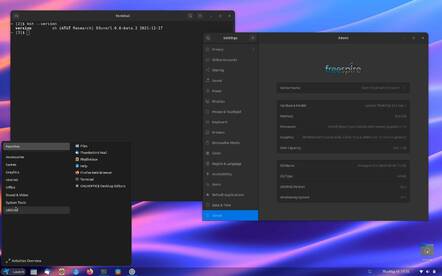An unexpectedly fresh blast from the past, Freespire 9.5 has landed
Remember Linspire, formerly known as LindowsOS? It's now Freespire and thriving
A descendant of one of the oldest desktop Linuxes around surprises… both by existing at all, as well as by being impressively good.
The newly released Freespire 9.5 is the latest version of the free member of the Linspire family. It's based on Ubuntu 22.04.2, including GNOME 42.5, heavily customised to resemble Windows via a suite of GNOME extensions. Linspire removes Ubuntu's Snap packaging system and replaces it with Flatpak, but has no Flatpaks preinstalled.
It does come with an assortment of other apps, including two orthodox file managers, both console-mode (Midnight Commander) and graphical (Worker), the original Korn shell, OnlyOffice as its office suite, native Debian-packaged Mozilla Firefox and Thunderbird. Although it's mainly GNOME-based, it includes KDE's Discover app store and Muon package manager plus some smaller accessories.
This distro, despite its modest version number, is the latest offshoot of one of the first ever desktop-focused Linuxes. Writing about Freespire in 2023 comes as a considerable surprise for the Reg FOSS desk, because we thought the brand had disappeared about 15 years ago. We're delighted to be wrong about this, because this is a really good and highly appealing desktop distro – as befits something with an over-20-year pedigree. This is no me-too offering.
Desktop Linux has been around longer than you might think. It didn't begin with Ubuntu in 2004; in fact, what was innovative about Ubuntu wasn't its desktop focus, it was the fact that it was completely free. Various companies had been making desktop-centric distros for years before that, but they were all commercial in nature.
One of the highest profile was Lindows, which The Reg was covering way back in 2002. The company's distro, originally known as LindowsOS, was pioneering in several respects, some not obvious at the time. It was based on Debian, with a customized KDE desktop extensively tweaked to resemble Windows XP. Although the company originally marketed it as compatible with Windows applications thanks to the inclusion of an early version of WINE, that tech really wasn't ready for prime time yet. The truly innovative element was the Click'n'Run Warehouse, the world's first online app store, half a decade before the iPhone.
Microsoft sued the company over the name being too close to Windows. The company defended itself but in the end renamed itself Linspire and even sold off its sign – CEO Michael Robertson had great skills in getting media attention.
When Microsoft threatened to sue the Linux industry, Linspire was one of relatively few companies to sign a patent-sharing agreement. Rival desktop Linux vendor Xandros subsequently acquired the company and discontinued the distro.
We confess we thought that was the end, but we are happy to admit we were wrong. North Carolina FOSS vendor PC/OpenSystems (no, not that North Carolina FOSS vendor) bought the Linspire and Xandros brands and in 2018 launched new versions.
The new owners have not been idle, and the distro seems to be evolving quite quickly: for instance, version 9, at the start of this year, was based on Xfce 4.18. Regular readers may have noticed that The Reg FOSS desk isn't a big fan of GNOME, and we're not alone in this. Two other prominent companies offering distros derived from Ubuntu also modify GNOME: the Linux Mint team forked the whole desktop to create Cinnamon, while ZorinOS has its own set of in-house extensions to provide a "traditional" look and feel. Neither approach is ideal, in our humble opinion, and Freespire wins here by using mainstream components.
Freespire 9.5 has other, less-visible tweaks too. Vim is preinstalled for Stockholm Syndrome sufferers, but so is the much easier mcedit CUA-style editor. There's an optional alternative shell, badged "AT&T KornShell". There's a search button on the taskbar, and a link to GNOME's "overview" on the Launch menu. There are custom startup and shutdown screens, which have a more traditional appearance that we appreciated.
- DPL: Debian project has plenty of money but not enough developers
- A fine vintage: Wine has run Microsoft Solitaire on Linux for 25 years
- How Microsoft shattered Gnome's unity with Windows 95
- Microsoft milks Casio for using Linux
This is not a small distro. It insisted on a 20GB virtual hard disk just to install, and the heavily 3D-composited GNOME desktop runs very poorly under VirtualBox. If you want to give it a try, we suggest doing so on bare metal. But saying that, we are impressed by what's on show here.
It's not perfect: for instance, we missed an instantly available search facility on the "Launch" menu. On the boot menu, it still calls itself "Ubuntu", which is unhelpful. Both Wayland and X.org sessions are available: the customized GNOME one is, confusingly, also labelled "Ubuntu", and there's a "GNOME Classic" entry too… but that seems to be only half present, with no lower panel.
Hoever, as GNOME-based environments go, this is one of the best. ZorinOS is comparable and boasts more desktop layout options, but the latest version is still based on Ubuntu 20.04, which is looking long in the tooth now. It also costs money, and in return, is bloated with umpteen Flatpak apps. That's good for some, but not everyone will need podcast editing suites and so on. We suspect more people will appreciate Freespire's ribbon-driven office suite.
If you want Ubuntu's strong compatibility, but with a cleaned-up, more Windows-like desktop, natively packaged browser, and no Snaps, Freespire is here, bright and shiny and looking better than ever. ®

